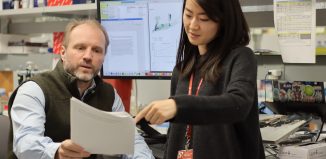Stony Brook’s Wang studies depth of cancer valleys
Picture a child on a bike circling the neighborhood. If the bike path has hills and valleys, the child needs to pedal harder to climb the hills, and can coast down to the valleys. When the child stops pedaling and lets the bike stop on its own, it is likely to rest at the bottom of a valley, the way an apple that falls from a tree at the top of a hill will come to a stop after rolling to the bottom.
Jin Wang applies the same logic to cells and cancer. A faculty member in the Chemistry Department and an adjunct faculty member in Physics at Stony Brook University, Wang said the interaction between the contours of a landscape and the energy to move around that space affects a cell’s fate.
“We have been looking at the underlying gene regulatory networks of cancer,” Wang said. “The normal cell, a cancer state, and apoptosis (or cell death) are all represented by valleys.”
Wang has been looking at the influence on the driving force from individual genes and gene regulations, or links between genes. He is planning to consider multiple genes and gene regulations.
“The way the genes are connected influences the shape of the underlying landscape, making it more or less likely to enter a particular phase,” he said. A deeper cancer valley could make it easier to get into that state and tougher to get out.
A physicist by training, Wang doesn’t have a lab where he does experiments at a bench. He collaborates with other researchers, develops mathematical models and analyzes the results.
Wang and his post doctoral student, Chunhe Li, recently published a paper on the hills and valleys in cancer in the Journal of the Royal Society Interface.
Wang said the cancer state is already present in many people’s genes, but they don’t necessarily get there because it is shallower with a lower probability, the barrier is too high or the force pushing in that direction is not enough. A mutation or the environment can change the shape of the landscape, tilting it towards cancer.
Wang also published work he’s done on something basic to the life of a cell, called the cell cycle. Cancer corrupts the speed of the cell cycle, often causing cells to grow and divide at a rate that is faster than normal.
In the cell cycle, a cell goes through several well-documented stages before it divides in two. During the interphase, the cell has a G1 period, where it prepares to copy its genes, or DNA. In the S phase, it builds a genetic twin, and in the G2 period, it goes through a stage where it checks to make sure the process worked correctly. At the end of G2, it goes into the M stage, where it divides.
Wang, Li and collaborators in China explored the landscape as the cell moves from one period to another. “We have a three dimensional shape of the cell cycle,” he said.
What drives the cell through these stages is a combination of the depth of the valleys and the nutrition in the cell. “The underlying landscape for the cell cycle for cancer and the normal state is different,” he said. “The hills between valleys for cancer may be lower so that traveling through the different valleys is easier.”Wang and Li published their paper in the Proceedings of the National Academy of Sciences.
Li, who has worked with Wang since 2012, called the approach Wang has taken with landscape and flux “original.”
“The landscape shape can be used as a potential way to design anti-cancer strategies, by targeting multiple genes and gene regulation patterns,” Li explained. “These findings shed light on the understanding of cancer mechanisms and provide some insight on cancer treatment.”
Wang explained that his framework for understanding the combination of a driving force and a contoured environment could also have applications in other arenas, such as psychology, where people have natural steady-state valleys which require different levels of energy to change.
Wang grew up in China, where both of his parents were chemists. He has been on Long Island for a decade. He has an appreciation for something many residents take for granted. “I like to watch the clouds moving,” he said. “Because Long Island is in a special geographic location, the water keeps vaporizing and going out” to form clouds of different shapes and speeds.
Wang sees other arenas to apply his framework, including in psychology and decision making. Future questions could include, he said, “How do you make a decision from an undecided valley to a decided valley?”






